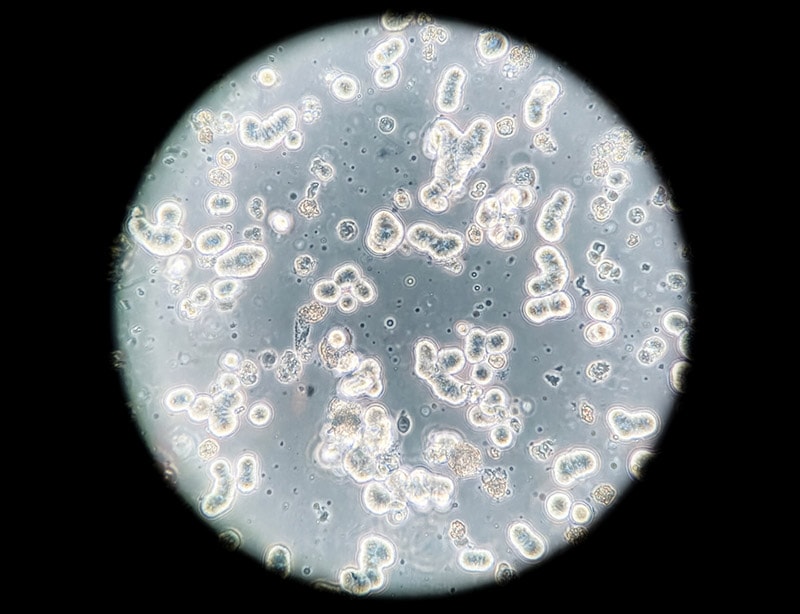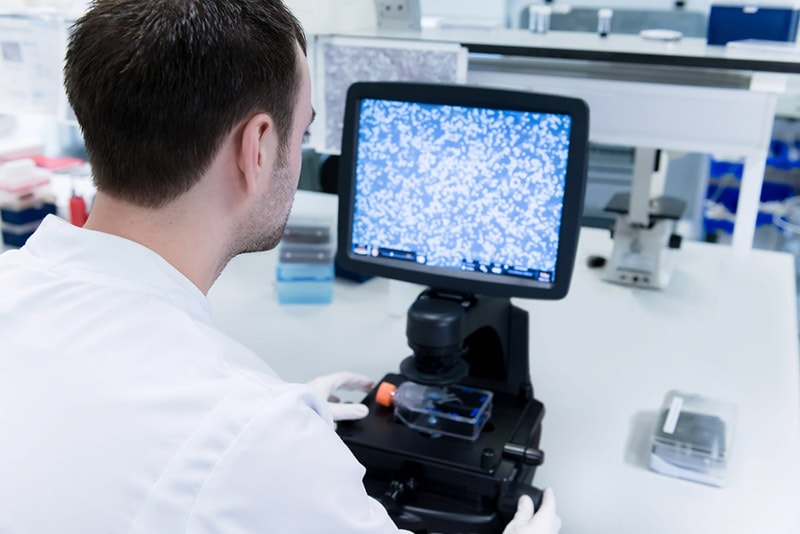What Do Cancer Cells Look Like Under a Microscope? The Interesting Answer!
Last Updated on

Have you ever wondered about the physical differences between healthy and cancerous cells? If you know what you are looking for, you can spot these differences with a microscope.
So, what do cancer cells look like under a microscope, and how do they differ from healthy ones? Cancer cells will usually be abnormally shaped, and the nucleus will be darker and larger. We break down everything that you need to know here, as well as answer a few questions about cancer cells.

How Can You Tell If a Cell Is Cancerous Under a Microscope?
There are a few different ways that you can tell that a cell is cancerous when looking at it under a microscope, but it all starts with knowing what a similar healthy cell looks like. From there, you can look for specific abnormalities.
Typically, cancerous cells have a larger and darker nucleus than normal cells. This typically happens because they have too much DNA. During a biopsy, physicians usually add a dye to the cell that makes the nucleus look even darker, making it easier to identify as cancerous.
However, while the nucleus is typically larger than a standard cell, the actual size of a cancerous cell can be larger or smaller. Cancer cells also typically have abnormal shapes compared to healthy cells.
Finally, you can tell a great deal by the arrangement of the cells under a microscope. There is a typical order of cells to help them complete their specific job. While healthy cells stick to this order, it’s more likely for cancer cells to arrange themselves in ways that they shouldn’t.
https://www.instagram.com/p/CCCvm0eB7a7/
How Big Is a Cancer Cell?
When we think of cancer, we think of tumors, which naturally leads some of us to believe that cancer cells are larger than healthy cells. But that is not always the case. In fact, sometimes, cancer cells are smaller than healthy cells.
The tumors form due to out-of-control cell replication, not necessarily because of the physical size of the cell itself. There are simply too many cells in one location, and this creates the tumor. However, the cells themselves are typically both smaller and larger than healthy cells.

Can You Tell If a Cell Is Cancerous With a Microscope?
If you know what you’re looking at, you can tell if a cell is cancerous with a microscope. The caveat to this is two-fold, though. First, you need a good biopsy sample. Second, you need a powerful enough microscope to see all the different aspects of the cell.
Also, you need to know what you’re looking at. If you don’t know what a similar healthy cell looks like, you have no way of knowing if the cells that you’re looking at are abnormal.
That’s why biopsy technicians receive special training and have special tools to help make the job easier for them so they can make accurate diagnoses.

Do Physicians Biopsy Cancer Cells With a Microscope?
When a physician says that they’re going to complete a biopsy, most of us have a general understanding of what this means: They are taking a sample of cells for testing. But how exactly do they test it?
There are various ways that a physician tests a cell sample for cancer, but one thing that they almost always do is look at it under a microscope. They look for abnormalities and signature traits, often using dyes and other test kits to make the distinctions more pronounced.
These are things that physicians have exclusive access to, so if you want to look at cancer cells yourself, you probably won’t be able to get the dyes and test kits that they use to make diagnostics easier and more accurate.

Final Thoughts
While nobody wants to develop cancer, the cells themselves are interesting to look at under a microscope. Advanced cancer cells look drastically different than healthy cells, and it’s not hard to see why they’re so detrimental to the body.
If you get the chance to look at both healthy and cancerous cells under a microscope, we highly recommend it for the educational value alone!
Featured Image Credit: Artur Wnorowski, Shutterstock
About the Author Robert Sparks
Robert’s obsession with all things optical started early in life, when his optician father would bring home prototypes for Robert to play with. Nowadays, Robert is dedicated to helping others find the right optics for their needs. His hobbies include astronomy, astrophysics, and model building. Originally from Newark, NJ, he resides in Santa Fe, New Mexico, where the nighttime skies are filled with glittering stars.
Related Articles:
What Is the Best Binocular Magnification for Hunting? Optical Features Explained
Can You Use Binoculars to Look At Stars? How to Choose the Right Pair
How to Clean a Refractor Telescope: Step-by-Step Guide
How to Clean a Telescope Eyepiece: Step-by-Step Guide
How to Clean a Rifle Scope: 8 Expert Tips
Monocular vs Telescope: Differences Explained (With Pictures)
What Is a Monocular Used For? 8 Common Functions
How to Clean a Telescope Mirror: 8 Expert Tips
